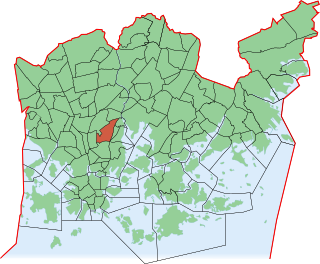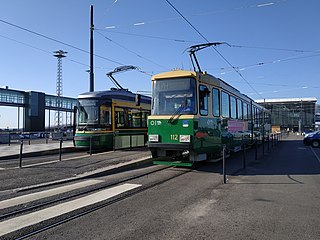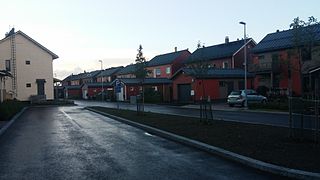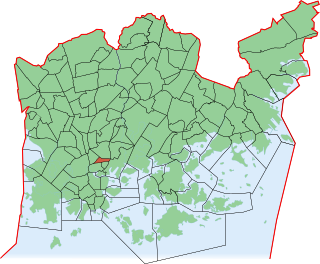
Töölö is the collective name for the neighbourhoods Etu-Töölö and Taka-Töölö in Helsinki, Finland. The neighbourhoods are located next to the city centre, occupying the western side of the Helsinki Peninsula.

Arabianranta, sometimes simply Arabia, is a residential part of Helsinki, Finland. It is bound by Vanhankaupunginlahti bay from east, and connects to neighboring boroughs of Vanhakaupunki in north, Hermanni in south and Toukola and Kumpula in west. It is part of the greater Toukola region.

Kamppi is a neighbourhood in the centre of Helsinki, the capital of Finland. The name originally referred to a small area known as the "Kamppi field", but according to the current official designation, "Kamppi" encompasses a much larger area with a population of 10,000 in 2004.

Littoinen is a village in south-western Finland, centred on Lake Littoinen. The village is shared between the town of Kaarina and the municipality of Lieto, and it borders the regional centre of Turku. It started growing after the founding of a broadcloth factory by Lake Littoinen in 1739, and the railway connection built in 1899 increased its growth. In the 1960s the operations of the broadcloth factory were discontinued due to decreased demand, but the premises still exist and have been transformed into residential and commercial spaces. The factory's heritage is still visible in the village's place and street names.

Arabia was a Finnish ceramics company, founded in 1873 by Rörstrand, now owned by Fiskars. Arabia has specialized in faience and porcelain kitchenware and tableware.
Helsinki Railway Square is an open square immediately to the east of the Helsinki Central railway station in central Helsinki in Finland. The square serves as Helsinki's secondary bus station along with the main Kamppi Center bus station. The north side features the Finnish National Theatre, and the south side is formed of the Ateneum classical art museum. To the west side are the two ornate entrances to Helsinki Central station—a bigger one for public use, and a smaller one exclusively for the President of Finland and their official guests. The square is served by the Helsinki Metro system with Rautatientori metro station entrances at the south-west corner, and University of Helsinki metro station to the east.

Vallila is a neighbourhood in Helsinki, the capital of Finland.
The city of Helsinki, the capital of Finland, can be divided into various sorts of subdivisions. Helsinki is divided into three major areas: Helsinki Downtown, North Helsinki and East Helsinki. The subdivisions include boroughs, districts, major districts and postal code areas. The plethora of different official ways to divide the city is a source of some confusion to the inhabitants, as different kinds of subdivisions often share similar or identical names.

Vanhakaupunki is a neighbourhood of the city of Helsinki, Finland, to the north of Toukola. It is also the name of a district of the city, which contains the neighbourhood and its surroundings. The name comes from the fact that Helsinki was originally founded in the Vanhakaupunki area. The Swedish name Gamla Helsingfors appears in the new Helsinki foundation document from 1639, as the city was moved to its later location, and the forms Gamla staden or Gammelstaden came into use after this. The Finnish translation of the name only started appearing in the late 19th century. The current names were established as official in 1909. The neighbourhood was named Vanhakaupunki in 1959.

Kumpula is a verdant neighbourhood in Helsinki, bordered by Eastern Pasila to the west, Vallila to the south, Käpylä and Koskela to the north and Toukola and Arabianranta to the east. As of January 1, 2003, Kumpula had approximately 3,600 inhabitants.

West Harbour is a passenger and cargo harbour in the Jätkäsaari district of Helsinki, Finland, in the southwestern part of the Helsinginniemi peninsula. The Länsisatama harbour area also includes the Munkkisaaren laituri pier on the west side of Munkkisaari, used by cruiseliners. The harbour is operated by the Port of Helsinki.

Ullanlinna is a city district of Helsinki, in Finland. The name Ullanlinna refers to the fortification line that was built at the southern edge of the area during the 18th century, as part of the town fortifications, which also included the fortress of Suomenlinna. The name Ulla refers to the Swedish Queen Ulrika Eleonora (1688–1741). During the 19th century the area was dominated by summer pavilions owned by the wealthy Helsinki middle-classes. The appearance of the area changed gradually at the end of the 19th century as the wooden houses were replaced with much higher stone buildings, designed in the prevailing Jugendstil architectural style synonymous with National Romanticism.

Torpparinmäki (Finnish), Torparbacken (Swedish) is an area in Helsinki, Finland, and in turn part of the Greater Helsinki area. Torpparinmäki is a residential area along Tuusulanväylä, situated north of Kehä I. At the end of 2022, 2,785 inhabitants lived in the area.

Harju is a quarter of Helsinki, Finland. It is located northeast of the city centre, part of Alppiharju neighbourhood, between the quarters of Alppila, Torkkelinmäki, Linjat and the neighbourhoods of Sörnäinen and Vallila. Harju has a population of 7,237 and an area of 0.27 km2.

The Helsinki urban area is the largest urban area in Finland. It is located in the Uusimaa region in Finland and has about 1.36 million inhabitants as of 2023, making it the second largest urban area in the Nordic countries.

Töölöntori is an urban square and marketplace in the Töölö district of central Helsinki, Finland. It is bounded in the west by Runeberginkatu and the southern end of Topeliuksenkatu, in the north by Tykistönkatu; Töölöntorinkatu forms its eastern limit, and Sandelsinkatu its southern.

The Statue of Johan Ludvig Runeberg is a statue dedicated to the Finland-Swedish author, national poet and priest Johan Ludvig Runeberg (1804–1877), designed and sculpted by his son Walter Runeberg (1838–1920). The statue is located in the Esplanadi park in Helsinki.
Hanasaari is a neighbourhood in the district of Sörnäinen in Helsinki, Finland, between the neighbourhoods of Vilhonvuori, Kalasatama and Sompasaari near Merihaka. The name comes from an island that was lost under reclaimed land. Hanasaari has primarily been a power plant area, although the plant has already been shut down. The first power plant was built next to Hanasaari in Suvilahti.

The Eliel Square is a square on the west side of the Helsinki Central Station in the heart of Helsinki, Finland. It is named after the railway station designer Eliel Saarinen. The square is for the most part the departure and arrival platforms for regional buses.

Keisarinnankivi is a monument located at the Market Square in Kaartinkaupunki in central Helsinki, Finland. The monument, designed by Carl Ludvig Engel, is the oldest public monument in Helsinki. It was revealed with celebrations on the name day of Nikolai on 18 December 1835 to commemorate the first visit to Helsinki by Empress Alexandra Feodorovna, wife of Emperor of Russia Nicholas I. The monument was erected at the spot where the imperial couple stepped ashore from the steamship Ischora on arrival in Helsinki on 10 June 1833. The monument was funded by a national collection of funds and by a grant given by the Imperial Senate of Finland.




















